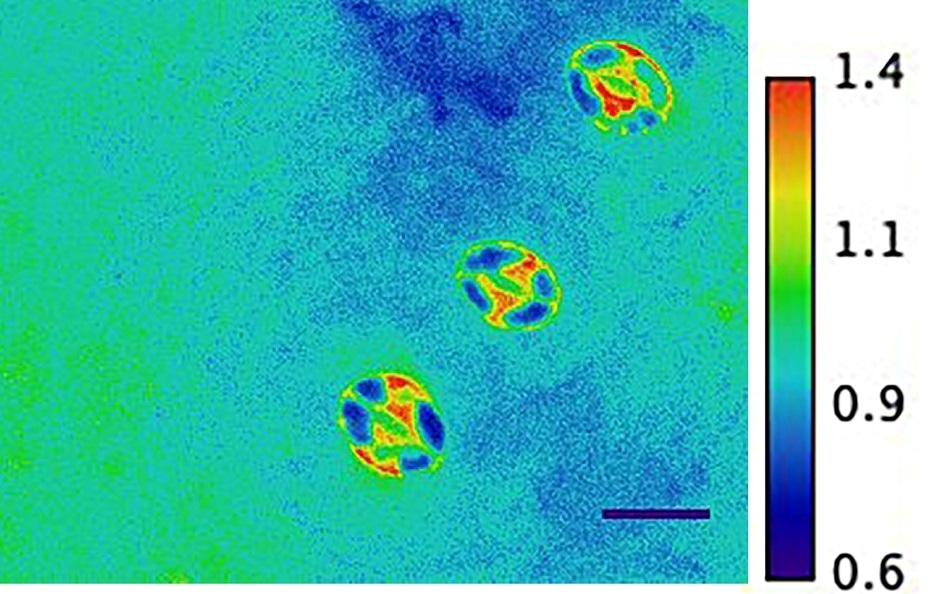For a long time, plant biologists have been looking to gain a better insight into the underlying processes involving enzymes—kinases that catalyze vital biological activities in proteins.

The image depicts three Arabidopsis leaf surface pores, or stomata, expressing the new SNACS stress nanosensor developed by UC San Diego plant biologists. Image Credit: Schroeder Lab, University of California San Diego.
There is a greater need to analyze the fundamental processes in plants, especially in the current environment that is increasingly being changed by climate warming.
Specific “SnRK2” kinases (sucrose-non-fermenting-1-related protein kinase-2s) are crucial because they are stimulated in response to drought conditions, activating the protective closure of tiny pores present on the surfaces of leaves called stoma.
These tiny pores enable the carbon dioxide gas to penetrate the leaves; however, plants also lose over 90% of their water by evaporation through the stoma. Functions like opening and closing of pores support optimized growth and drought tolerance in reaction to environmental changes.
Plant biologists from the University of California San Diego have now developed a unique nanosensor that enables scientists to track the activity of the SnRK2 protein kinase in live plant cells. The SnRK2 activity sensor, or “SNACS for short,” has been detailed in the eLife journal.
Previous attempts to study the activities of protein kinase were an intensive process, in which plant tissues are ground and kinase activities are measured through cell extracts.
To analyze the stomatal pore-forming “guard cells,” over 100 leaves were needed for each experiment. Now, SNACS enables scientists to examine real-time changes as they occur.
Previously, it was not possible to investigate time-resolved SnRK2 activity in living plant cells. The SNACS sensor reports direct real-time visualization of SnRK2 kinase activity in single live plant cells or tissues.”
Julian Schroeder, Study Senior Author and Distinguished Professor, Division of Biological Sciences, University of California San Diego
Schroeder is also a member of the Section of Cell and Developmental Biology.
The novel biosensor has already proved to be advantageous. The scientists revealed that through the SNACS, they were able to offer unique evidence related to the age-old questions about SnRK2 and foundational communications with the carbon dioxide gas.
The scientists demonstrated that kinases are activated by abscisic acid—a drought stress hormone found in plants—and not by increased concentration of carbon dioxide, thereby resolving a newly debated question.
Our findings could benefit researchers investigating environmental stress responses in plants and analyzing how different signaling pathways interact with one another in plant cells.”
Yohei Takahashi, Study Co-Corresponding Author and Project Scientist, University of California San Diego
“The ability to investigate time-resolved SnRK2 kinase regulation in live plants is of particular importance for understanding environmental stress responses of plant cells,” Takahashi concluded.
The researchers developed the new nanosensor by using a method pioneered by late Professor Roger Tsien from the University of California San Diego, in part for which he received a Nobel Prize.
Source:
Journal reference:
Zhang, L., et al. (2020) FRET kinase sensor development reveals SnRK2/OST1 activation by ABA but not by MeJA and high CO2 during stomatal closure. eLife. doi.org/10.7554/eLife.56351.